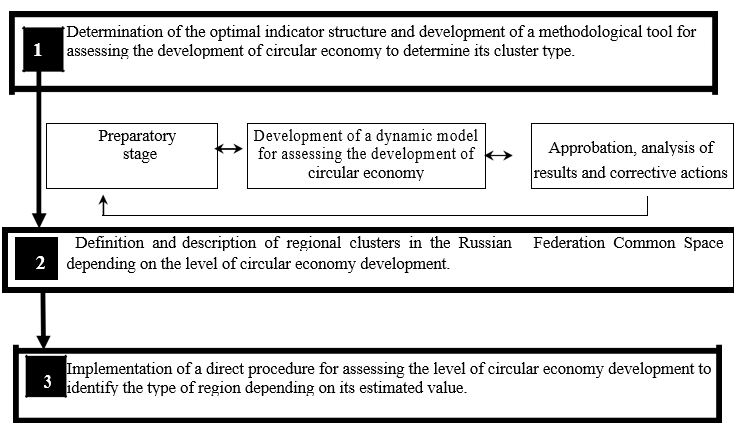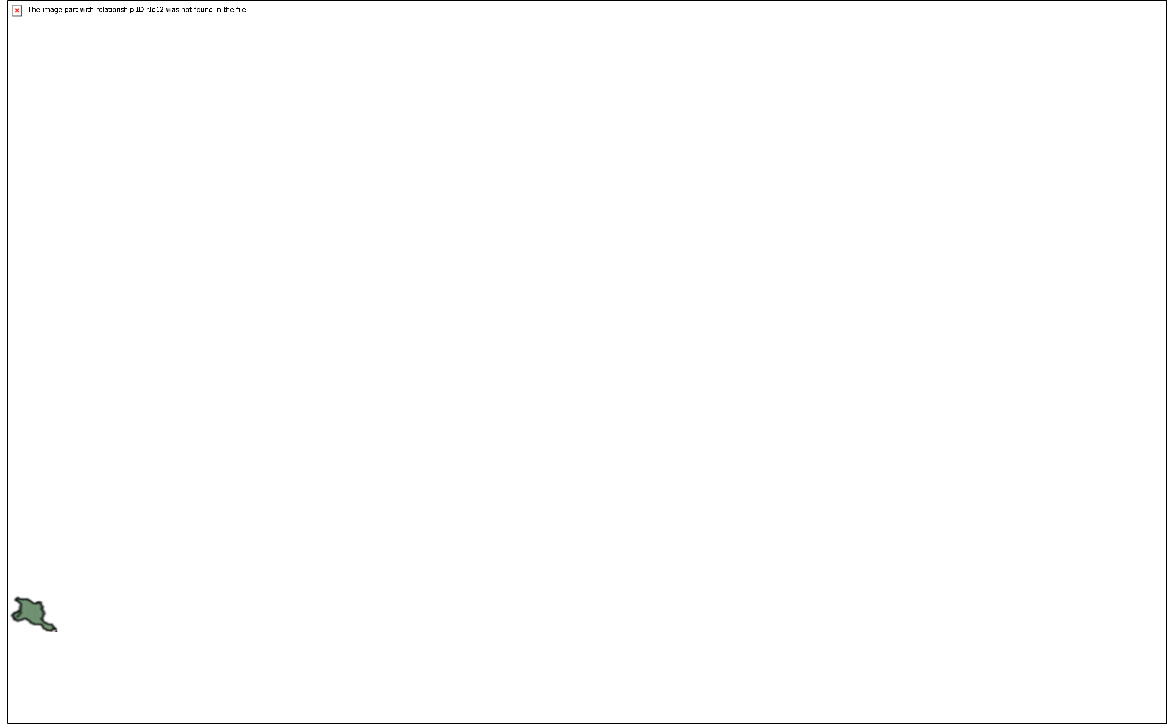Abstract
The basic principles of the development of territorial space have attracted the interest of researchers for several decades. An important aspect is a study and research for the relationship between impact factors and the resulting development effects. Achievement of sustainability in transforming space is extremely important not only from the economic and political perspective, but also from the perspective of social development. Recently, the focus has shifted from a linear-type economic model to a closed-loop model, due to a number of objective new economic and ecological reasons. To continue learning the phenomenon of circular economy on the example of regional subjects of Russia the article carried out the procedure of their clustering on the basis of actual statistical data, revealed the distinctive features describing the specific development of space due to "circular principles" and gave the characteristics of cluster formations on the basic descriptive features of each group of cluster elements. More effective implementation of the principles of circular economy in the socio-economic space of the regions opens new horizons for strategic planning and management of their development. The information obtained from the analysis will contribute to the optimization and early establishment of equalization and harmonization of regional policies on sustainable development and the circular economy.
Keywords: Circular economyeconomic spaceregional developmentsustainable development
Introduction
The study of territorial space from the cluster approach has special advantages especially evident in the current crisis period of the global economy caused by the COVID-19 virus pandemic. Territorial clusters are strategic points of support for management decisions in the regional and national blocs, contribute to the formation of investment attractiveness of regions, create new jobs, thus strengthening the position of sustainable development. Nowadays it is extremely important to find new stimuli for economic growth, part of the scientific world community believes that its source is the shift of the economic growth paradigm model from linear to circular. Consequently, there is a certain interest in defining the specificity of economic space under the influence of circular economy.
Problem Statement
The Russian researchers repeatedly note the relevance of the cluster approach in improving management decisions. For example, in Savzihanova (2014) wrote about the role and formation of the cluster; Zharkova (2017) considered the integration of the cluster and the special economic zone; Groshev et al. (2019a, 2019b) paid a close attention to systemic contradictions in the cluster initiatives; Malov and Letyagina (2019) proposed a neural network model of the clustering of the economy; the work of Kookueva and Tserceil (2019, 2019b) and other researchers (Andreeva & Astanina, 2018; Yagolnitzer & Kolobova, 2018) studied the questions of the formation of innovative territorial clusters.
Research Questions
The hypothesis assumes that the circular economy imposes distinctive, specific features conditioning the development of the regional space, allowing to identify new cluster formations at the regional and sub-regional levels, thereby contributing, in the future, to modernize management decision-making and reach a qualitatively new level of development of regional sustainability, additionally forming a favorable circular environment for strengthening the key R-principles of circularity.
Purpose of the Study
As the main purpose the author designates identifying specific features of regional space development from the position of circular economy by conducting clustering and, based on the identified clusters, developing program proposals for the implementation of principles of circular economy.
The elements of scientific novelty are in the procedure of clustering the subjects of Russia from the position of the achieved level of circular economy development (using QuiiskMap2 software products, VBA Projects, IBM SPSS Statistics) and in the elaboration of possible scenarios for the strategic development of circular economy.
Research Methods
Due to the interest of the world scientific community in the search for new sources of social and economic growth and the increased interest of government and business representatives in ecological issues, considering the move of ongoing programs related to sustainable development, it is necessary to have a picture about specifics of the impact of the circular economy on the activities of the Russian regions for developing the most effective managerial decisions.
Figure

According to modern ideas about the sustainable development of society, the research has previously identified key indicators that incorporate the main characteristics necessary to assess the level of development of the circular economy and reflect the specifics of the economic space. To continue the study, it tested the developed formula of dynamic model of circular economy described by the multiple regression equation (Guryeva, 2020). The scale of calculations is performed on the base of statistical data from 85 Russian regions in the 2014-2019 period (Federal State Statistics Service, 2019; Federal State Statistics Service, 2020; Russian Government, 2020; Unified portal of the budget system of the Russian Federation, 2020).
Findings
The received data are processed in the software product of QuiiskMap2 package (Practical Science, 2020) and visualized by means of equally filled distribution of the calculated values on 7 groups according to recommendations at social and economic space planning (Kurushina & Druzhinina, 2016; Decree of the Government of the Russian Federation of 17.11.2008 No. 1662-R, 2017). Figure

The presented classification groups of regions make it possible to generalize several obvious specific features of space development under the influence of the circular economy:
the high level of development of the circular economy manifests largely in the regions with more favorable ecological conditions. Consequently, we can assume an interdependency between the degree of personal ecological literacy and society's ability to transmit it to the natural environment;
regions with increasing economic prosperity, as a rule, demonstrate a relatively negative level of circularity development, which directly proves the insufficiently balanced strategy of the region, where economic goals prevail over ecological ones. Targeted application of the existing competitive conditions and investment attractiveness of these subjects will contribute to the rapid growth of the circular economy;
regions with weakened economic component have higher level of circularity, which may mean, on the one hand, openness and flexibility in search of new opportunities to achieve a sustainable state, some increased readiness for dynamic changes; on the other hand, it may mean anthropogenic impact, caused by less active economic activity of the person, causes less damage to ecology. Subjects need a concentrated superstructure in the block of management decisions to realize the existing potential of the regions-subjects in the stability area.
To further study the phenomenon of circular economy on the example of regional subjects of Russia, the author conducted a procedure of vertical hierarchical clustering in the IBM SPSS Statistics 26 (Predictive Solutions, 2020) software package by means of the Classification tool, Ward methods and intergroup communication, using the interval measure "Euclidea Square" in both cases. The comparative analysis uses the Ward method of clustering, which initially considers each subject as a single cluster (Table
Table
More effective implementation of the principles of circular economy in the socio-economic space of the regions opens new horizons for strategic planning and management of their development. The information obtained through the analysis will contribute to the optimization and early establishment of the equalization and harmonization processes of the regional policy in the field of sustainable development and circular economy, which is fully consistent with the goal 2.3 "Sustainable nature management" and objectives 2.3.1 " Ecological education", 2.3.2 "Ecology of the natural environment, human ecology", 2.3.3 "Ecology of production, ecobusiness", prescribed in the Strategy of socio-economic development of the Tyumen Region until 2030 (Ministry of Economic Development of the Russian Federation, 2020).
Conclusion
Depending on the combination of external and internal factors, it is reasonable to provide for several most probable scenarios of strategic development of circular economy in the Tyumen region, presented in Table
The main practical effects resulting from the study include increased efficiency in the elaboration of strategic development programs for regional subjects of the Russian Federation, optimization in the achievement of key parameters of life quality to fulfill basic obligations in the field of sustainable development, and circular economy. We see further development of the fundamental concept in the possibility of creating a regional integrated program of circular economy for the socio-economic territorial space of the region, which should be scaled up and modernized into national projects of Russia, in the case of proved efficiency of implementation.
Acknowledgments
The research was carried out with the financial support of the Grant of the President of the Russian Federation to support young scientists of Candidates of Sciences within the framework of research MK-587.2019.6 "Development of theoretical and methodological foundations of the concept of circular economy as a new trend of formation of sustainable socio-economic space".
References
- Andreeva, T. A., & Astanina, L. A. (2018). Consideration of specific features of innovation and industrial clusters in programming regional cluster policy. Creative Economy, 12(11), 1807-1824. https://doi.org/10.18334/ce.12.11.3953
- ConsultantPlus. (2020). Constitution of the Russian Federation. http://www.consultant.ru/document/cons_doc_LAW_28399
- Decree of the Government of the Russian Federation of 17.11.2008 No. 1662-R (2017). On the Concept of Long-Term Socio-Economic Development of the Russian Federation for the Period up to 2020. http://www.consultant.ru
- Federal State Statistics Service. (2019). About the Sustainable Development Goals. https://gks.ru/sdg
- Federal State Statistics Service. (2020). Russia in Numbers-2019. https://www.gks.ru/bgd/regl/b19_11/Main.htm
- Groshev, A. R., Pelikhov, N. V., & Permyakov, P. Yu. (2019a). Cluster initiative: contradictions and peculiarities in the management of processes of clustering of regional economy. Economics, Entrepreneurship, and Law, 9(4), 355-370. https://doi.org/10.18334/epp.9.4.41412
- Groshev, A. R., Pelikhov, N. V., & Permyakov, P. Yu. (2019b). Systemic contradictions in the management of clustering processes in the regional economy. Economic Attitude, 9(4), 2965-2978. https://doi.org/10.18334/eo.9.4.41269
- Guryeva, M. A. (2020). Development and testing of the methodological toolkit for complex assessment of circular economy development. Innovative Economy Issues, 10(3), 1425-1448.
- Kookueva, V. V., & Tserceil, Yu. S. (2019a). Formation of the innovation territorial clusters in Russia. Creative Economy, 13(5), 957-970. https://doi.org/10.18334/ce.13.5.40618
- Kookueva, V. V., & Tserceil, Yu. S. (2019b). Overview of the foreign experience of the cluster policy implementation in territory development. Russian Entrepreneurship, 20(1), 401-414. https://doi.org/10.18334/rp.20.1.39512
- Kurushina, E. V., & Druzhinina, I. V. (2016). Human-Oriented Development of Russian Regions: A Textbook for Higher Education Institutions. TIU.
- Malov, D. N., & Letyagina, E. N. (2019). Development of a neural network model of clustering of economy for the analysis of investment attractiveness of enterprises. Creative Economy, 13(8), 1529-1536. https://doi.org/10.18334/ce.13.8.4093
- Ministry of Economic Development of the Russian Federation. (2020). Strategy of Socio-Economic DevelopmentoftheTyumenRegionUntil 2030. https://www.economy.gov.ru/-material/file/eb8fe06031f48f50686912b8b05b2445/14062019to.pdf
- Practical Science. (2020). QuickMap 2.2. http://www.sci.aha.ru/DG/qmap.htm
- PredictiveSolutions.(2020).IBMSPSSStatistics. http://www.predictivesolutions.
- ru/software/statistics.htm
- Russian Government. (2020). Information Materials about the National Project "Ecology". http://government.ru/info/35569
- Savzihanova, S. E. (2014). The role of the cluster in the development of the region's economy and increasing its competitiveness. Russian Entrepreneurship, 15(15), 95-102. https://creativeconomy.ru/lib/8403
- Unified portal of the budget system of the Russian Federation. (2020). Electronic Budget. http://budget.gov.ru
- Yagolnitzer, M. A., & Kolobova, E. A. (2018). Measuring the impact of institutional conditions on the formation of innovation clusters in Russian regions. Questions of Innovative Economy, 8(4), 661-678. https://doi.org/10.18334/vinec.8.4.39485
- Zharkova, N. N. (2017). Integration of the cluster and the special economic zone as a tool for implementing the Concept 2020. Economics, Business and Law, 7(2), 95-102. https://doi.org/10.18334/epp.7.2.38407
Copyright information

This work is licensed under a Creative Commons Attribution-NonCommercial-NoDerivatives 4.0 International License.
About this article
Publication Date
28 December 2020
Article Doi
eBook ISBN
978-1-80296-098-3
Publisher
European Publisher
Volume
99
Print ISBN (optional)
-
Edition Number
1st Edition
Pages
1-1040
Subjects
Multicultural context, learning environment, modern society, personality formation, informatization of the society, economics and law system of the region
Cite this article as:
Gureva, M. A. (2020). Regional Space From the Perspective of Circular Economy. In N. L. Shamne, S. Cindori, E. Y. Malushko, O. Larouk, & V. G. Lizunkov (Eds.), Individual and Society in the Modern Geopolitical Environment, vol 99. European Proceedings of Social and Behavioural Sciences (pp. 336-343). European Publisher. https://doi.org/10.15405/epsbs.2020.12.04.40

